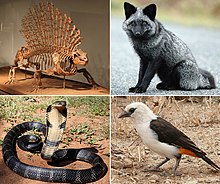
Back Amniota Afrikaans Amniota AN سلويات Arabic Амниоттар Bashkir Амніёты Byelorussian Амніёты BE-X-OLD Амниоти Bulgarian Amnioti BS Amniotes Catalan Blanatí Czech
This article needs additional citations for verification. (August 2022) |
| Amniotes | |
|---|---|

| |
| From top to bottom and left to right, examples of amniotes: Edaphosaurus, red fox (two synapsids), king cobra and a white-headed buffalo weaver (two sauropsids). | |
| Scientific classification | |
| Domain: | Eukaryota |
| Kingdom: | Animalia |
| Phylum: | Chordata |
| Superclass: | Tetrapoda |
| Clade: | Reptiliomorpha |
| Clade: | Amniota Haeckel, 1866 |
| Clades | |
Amniotes are tetrapod vertebrate animals belonging to the clade Amniota, a large group that comprises the vast majority of living terrestrial and semiaquatic vertebrates. Amniotes evolved from amphibian ancestors during the Carboniferous period and further diverged into two groups, namely the sauropsids (including all reptiles and birds) and synapsids (including mammals and extinct ancestors like "pelycosaurs" and therapsids). They are distinguished from the other living tetrapod clade — the non-amniote lissamphibians (frogs/toads, salamanders, newts and caecilians) — by the development of three extraembryonic membranes (amnion for embryonic protection, chorion for gas exchange, and allantois for metabolic waste disposal or storage), thicker and keratinized skin, and costal respiration (breathing by expanding/constricting the rib cage).[3][4][5][6]
All three main amniote features listed above, namely the presence of an amniotic buffer, water-impermeable cutes and a robust air-breathing respiratory system, are very important for living on land as true terrestrial animals — the ability to survive and procreate in locations away from water bodies, better homeostasis in drier environments, and more efficient non-aquatic gas exchange to power terrestrial locomotions, although they might still require regular access to drinking water for rehydration like the semiaquatic amphibians do. Because the amnion and the fluid it secretes shields the embryo from environmental fluctuations, amniotes can reproduce on dry land by either laying shelled eggs (reptiles, birds and monotremes) or nurturing fertilized eggs within the mother (marsupial and placental mammals), unlike anamniotes (fish and amphibians) that have to spawn in or closely adjacent to aquatic environments. Additional unique features are the presence of adrenocortical and chromaffin tissues as a discrete pair of glands[7]: 600 near their kidneys, which are more complex,[7]: 552 the presence of an astragalus for better extremity range of motion,[8] and the complete loss of metamorphosis (which includes an egg and aquatic larval stage), gill and skin breathing, and any lateral line system.[7]: 694
The first amniotes, referred to as "basal amniotes", resembled small lizards and evolved from semiaquatic reptiliomorphs about 312 million years ago[9] during the Carboniferous period. After the Carboniferous rainforest collapse, amniotes spread around Earth's land and became the dominant land vertebrates,[9] and soon diverged into the synapsids and sauropsids, whose lineages both still persist today. The oldest known fossil synapsid is Protoclepsydrops from about 312 million years ago,[9] while the oldest known sauropsid are probably Hylonomus and Paleothyris in the order Captorhinida, from the Middle Pennsylvanian epoch (c. 306–312 million years ago). Older sources, particularly before the 20th century, may refer to amniotes as "higher vertebrates" and anamniotes as "lower vertebrates", based on the antiquated idea of the evolutionary great chain of being.
- ^ Paton, R. L.; Smithson, T. R.; Clack, J. A. (8 April 1999). "An amniote-like skeleton from the Early Carboniferous of Scotland". Nature. 398 (6727): 508–513. Bibcode:1999Natur.398..508P. doi:10.1038/19071. ISSN 0028-0836. S2CID 204992355.
- ^ Irmis, R. B.; Parker, W. G. (2005). "Unusual tetrapod teeth from the Upper Triassic Chinle Formation, Arizona, USA". Canadian Journal of Earth Sciences. 42 (7): 1339–1345. Bibcode:2005CaJES..42.1339I. doi:10.1139/e05-031. S2CID 46418796.
- ^ Benton, Michael J. (1997). Vertebrate Palaeontology. London: Chapman & Hall. pp. 105–109. ISBN 978-0-412-73810-4.
- ^ Cieri, R.L., Hatch, S.T., Capano, J.G. et al. (2020). Locomotor rib kinematics in two species of lizards and a new hypothesis for the evolution of aspiration breathing in amniotes. Sci Rep 10. 7739. https://doi.org/10.1038/s41598-020-64140-y
- ^ Janis, C. M., Napoli, J. G., & Warren, D. E. (2020). Palaeophysiology of pH regulation in tetrapods. Philosophical Transactions of the Royal Society B: Biological Sciences, 375 (1793), 20190131. https://doi.org/10.1098/rstb.2019.0131
- ^ Hickman, Cleveland P. Jr (17 October 2016). Integrated principles of zoology (Seventeenth ed.). McGraw-Hill. pp. 563–567. ISBN 978-1-259-56231-0.
- ^ a b c Kardong, Kenneth V. (16 February 2011). Vertebrates: Comparative Anatomy, Function, Evolution. McGraw-Hill. ISBN 978-0-07-352423-8.
- ^ Clack, Jennifer A. (27 August 2023). Gaining Ground: The Origin and Evolution of Tetrapods. Indiana University Press. p. 370. ISBN 978-0-253-35675-8.
- ^ a b c Benton, M.J.; Donoghue, P.C.J. (2006). "Palaeontological evidence to date the tree of life". Molecular Biology and Evolution. 24 (1): 26–53. doi:10.1093/molbev/msl150. PMID 17047029.
© MMXXIII Rich X Search. We shall prevail. All rights reserved. Rich X Search